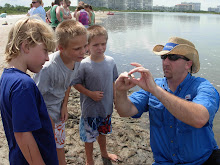Yesterday I was fortunate enough to spend the morning assisting a colleague from Rookery Bay with a field trip for high school marine science students from Gulf Coast High School. We couldn't have asked for a better day! We started off our boat trip discussing the importance of water quality to the health of the estuary and explained Rookery Bay's water quality monitoring program. We split the students up into small groups to collect data on salinity, pH, and turbidity. We did our testing near the mouth of Henderson Creek to emphasize the importance of freshwater input (or more specifically lack of freshwater in the case of Henderson Creek)

Next we headed towards Keewaydin Island to do a trawl, which is always one of my favorite activities. I have to admit we didn't catch a lot of stuff, but we certainly had a decent amount of diversity. Our catch included a juvenile stone crab, 9-armed sea star, brittle star, spotfin mojarra, polka-dot batfish, hardhead catfish, comb jellies, and sponge pieces. The students seemed to enjoy it, especially the batfish as this was the first time many of them had ever seen one. We also had the students pick through the sponge pieces to look for specimens hiding among them; they found lots of porcelain crabs! At the end of the trip we discussed the importance of having a citizenry, no matter what their profession is, who recognizes and understands the importance of a healthy estuary to the long-term sustainability of our economy and livelihoods. I was very impressed with the class's knowledge and insights. Enjoy the pictures!!
 |
| Investigating the catch of the day! |
 |
| Mrs Libby showing her students the Polka-dot batfish we caught in the trawl. |
 |
| A student checks out the juvenile stone crab we caught. |
 |
Rookery Bay educator Meredith Bayer shows the class a
9-armed sea star's tube feet. |
 |
| The hardhead catfish we caught. |
 |
Students examine the insides of a sponge piece we caught in the trawl.
|












No comments:
Post a Comment